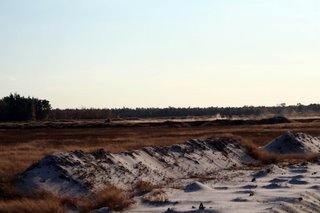 I'm including this photo of a commercial cranberry farm to give an idea of how large the operation is. In the immediate foreground is the canal that surrounds the bog, just visible to the right is a gate used to control water flow in and out of where the cranberries are grown and harvested. Elevated dikes surround each bog. I think most farms flood their fields prior to harvest and leave them that way during the winter freeze to protect the cranberry plants. Most, if not all of these *wet-harvested* cranberries are destined for the juice market and I believe that the farmers are part of a cooperative that produces for Ocean Spray.
I'm including this photo of a commercial cranberry farm to give an idea of how large the operation is. In the immediate foreground is the canal that surrounds the bog, just visible to the right is a gate used to control water flow in and out of where the cranberries are grown and harvested. Elevated dikes surround each bog. I think most farms flood their fields prior to harvest and leave them that way during the winter freeze to protect the cranberry plants. Most, if not all of these *wet-harvested* cranberries are destined for the juice market and I believe that the farmers are part of a cooperative that produces for Ocean Spray.  All of the equipment used in the harvest was at the far end of view, but if you use your imagination you can see that green machine with the yellow hose on it that is the *boom* used to corral the loose berries. I learned during the visit to Whitesbog Village that these booms were adapted from those used to clean up oil spills. It used to be that cranberries were harvested by people wading in the water and pushing the berries forward to a corner of the bog to be picked up on conveyor belts or the like, but the current method is much less labor-intensive. In the early days of cranberry farming, the berries were *dry harvested* by women and children walking the fields using metal or wooden scoops to pick the berries from the vines, much like blueberries, I guess.
All of the equipment used in the harvest was at the far end of view, but if you use your imagination you can see that green machine with the yellow hose on it that is the *boom* used to corral the loose berries. I learned during the visit to Whitesbog Village that these booms were adapted from those used to clean up oil spills. It used to be that cranberries were harvested by people wading in the water and pushing the berries forward to a corner of the bog to be picked up on conveyor belts or the like, but the current method is much less labor-intensive. In the early days of cranberry farming, the berries were *dry harvested* by women and children walking the fields using metal or wooden scoops to pick the berries from the vines, much like blueberries, I guess. Back to the abandoned bogs at Whitesbog - I took this pic of a few yahoos on motorbikes riding across the sandy dikes that traverse the bogs.
Back to the abandoned bogs at Whitesbog - I took this pic of a few yahoos on motorbikes riding across the sandy dikes that traverse the bogs.  Here's the bird pic of the day - that speck in the middle is a kestral forced to flight by the motorbikes. When I first arrived they were perched on the scrubby sand piles along the dike and would occasionally fly from their perches to hover over the brush below.
Here's the bird pic of the day - that speck in the middle is a kestral forced to flight by the motorbikes. When I first arrived they were perched on the scrubby sand piles along the dike and would occasionally fly from their perches to hover over the brush below.


8 comments:
Great photos...
Stupid yahoos.
I love those dunes! Too bad about the fools on motorbikes. If you get up to the Cape anytime soon, check out the dunes at Chapin Beach, mid-Cape.
I'm familiar with those wooden cranberry scoops. My great-aunt sold antiques on the Cape and her shop was called the Blue Scoop. And yes, she had a big ol' blue cranberry scoop right out there by her driveway, in case anyone didn't understand.
You're really taking me down memory lane!
Thanks for that story Laura. I never knew how that was done and with Thanksgiving coming up, cranberries are always on the table.
In my younger days, I was a cross country truck driver. The company I worked for had a terminal in Cranberry, NJ. The company is long gone, but I remember going there. It's true that a lot of NJ is an industrial state, but there are plenty of rural areas to see. Many old towns kept the same way for years and so clean. It was always a nice place to visit on my trips.
Thank you again for telling us about cranberry bogs - it's really interesting to see where some of my favorite food / juice comes from!
Susan: I don't get they were bothering anyone but me.
Bunnygirl: Those aren't exactly dunes like you see at the beach - the soil in the pine barrens is so very sandy and nutrient poor - not sure why it's mounded up like that. Do cranberries grow on Cape Cod in marshes near the beach?
Dave: I don't know where Cranberry is - I used to visit my uncle's vacation cottage in Cranberry Lake - wonder if it's the same place. The book about the Pine Barrens that I'm reading now points out that NJ has always been a corrider between NYC and Philly - so often all people see of it is what is glimpsed from the highways.
Naturewoman: Wish I had better pics, but there is another place I may visit where they are also farmed.
I've enjoyed reading your pieces on the cranberry bogs in your area. I know of a few up this way, but nothing so large. One of the things I most like about visiting your blog is your photos and descriptions of places in your region. It seems like a wonderful place to reside.
Thanks for the introduction to cranberry bog farming. I never thought about how the abandoned bogs might look. Do you know if there are contamination issues from agricultural chemicals when they abandon them?
Bev: Nice to see you back! I think one of the nicest things about NJ is the diversity, really.
Lene: I think that the abandoned ones in the photos were farmed early in the century, so I don't guess contamination would be an issue.
The commercial farms are another story, I'd bet. I think the farms take advantage of what's natural about the area and turn it into a monoculture - of course there is no plant diversity like in a natural bog. Not in the pics, but I saw this humungous machine used to spray pesticides, it stretched the full width of each farmed bog.
I'd be interested to know more about the environmental effects, also.
Post a Comment